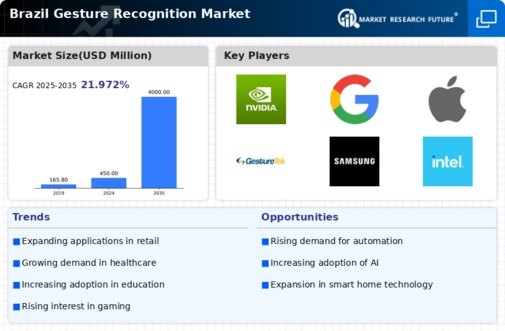Technological Advancements in AI
The gesture recognition market in Brazil is experiencing a surge due to rapid advancements in artificial intelligence (AI) technologies. These innovations enhance the accuracy and efficiency of gesture recognition systems, making them more appealing to various sectors. For instance, the integration of machine learning algorithms allows for improved pattern recognition, which is crucial for applications in gaming, automotive, and smart home devices. As AI continues to evolve, it is expected that the gesture recognition market will expand significantly, with projections indicating a growth rate of approximately 25% annually. This growth is likely to attract investments and drive further research and development, thereby solidifying Brazil's position as a key player in the gesture recognition market.
Expansion of Smart Home Technologies
The expansion of smart home technologies in Brazil is significantly influencing the gesture recognition market. As more households adopt smart devices, the need for intuitive control systems becomes paramount. Gesture recognition offers a seamless way to interact with various devices, from lighting to security systems. This trend is likely to drive the market's growth, with forecasts indicating a compound annual growth rate (CAGR) of around 20% over the next five years. The gesture recognition market is poised to capitalize on this trend, as manufacturers develop more sophisticated systems that integrate with existing smart home ecosystems, enhancing user convenience and satisfaction.
Rising Interest in Gaming and Entertainment
The gaming and entertainment sectors in Brazil are increasingly embracing gesture recognition technologies, which serve as a catalyst for market growth. As gaming becomes more immersive, developers are incorporating gesture-based controls to enhance user engagement. This trend is evident in the rise of virtual reality (VR) and augmented reality (AR) applications, which rely heavily on gesture recognition for interaction. The gesture recognition market is expected to see substantial growth, with estimates suggesting a market size increase of $300 million by 2026. This interest in innovative gaming experiences is likely to drive further investment and development in gesture recognition technologies.
Government Initiatives Supporting Innovation
Government initiatives in Brazil aimed at fostering technological innovation are playing a crucial role in the growth of the gesture recognition market. Various programs and funding opportunities are designed to support research and development in emerging technologies, including gesture recognition. These initiatives not only encourage local startups but also attract international companies looking to establish a presence in Brazil. The gesture recognition market stands to benefit from these supportive measures, with potential funding reaching up to $200 million over the next few years. This environment of innovation is likely to stimulate advancements in gesture recognition technologies, positioning Brazil as a competitive player in the global market.
Increasing Demand for Contactless Interfaces
In Brazil, the growing demand for contactless interfaces is a major driver for the gesture recognition market. As consumers become more health-conscious and seek hygienic solutions, businesses are increasingly adopting gesture-based technologies to minimize physical contact. This trend is particularly evident in retail and hospitality sectors, where touchless interactions enhance customer experiences. The gesture recognition market is projected to benefit from this shift, with estimates suggesting a potential market value increase of $500 million by 2027. Companies are investing in gesture recognition systems to meet consumer expectations, thereby fostering innovation and competition within the market.

















Leave a Comment